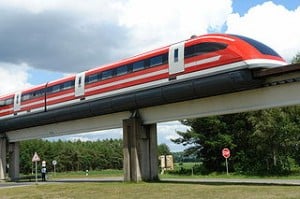There are many besides myself who have a deep interest in the railway realm. If you think about locomotive development over the ages, there have been many types or classes. When you get right down to the basics, locomotives are nothing more than power plants; power plants on wheels, that is.
Really quickly, there are three main propulsion types: steam, electric and diesel.

There are so many classifications of locomotives that naming them all, well, as I used to say in days of yesteryear, “let’s not and say we did” – it’s just an expression.
Locomotive design and development, in chronological terms, went from polluting to less polluting and non-polluting. Some of the more unusual designs bore names like “Porter” (a special applications type with smokeless boiler), “Tom Thumb” (and brethren equipped with vertical boilers) and “Turbo-train” (a gas turbine). The Porter would be a good example of a non-electric locomotive that was non-polluting. These locomotives contained boilers, but the water was heated external to the locomotive itself and then pumped into the locomotive’s boiler. When the water cooled enough, insufficient steam pressure rendered the locomotive incapable of performing its intended duties. Resupplying the boiler with water heated to a high enough temperature, and the locomotive was back in business.
![320px-WilliamsDepot_WilliamsAZ[1]](https://alankandel.scienceblog.com/files/2013/02/320px-WilliamsDepot_WilliamsAZ1-300x200.jpg)

There were others still that were tried. Exported here to the U.S. from Germany was a small order of Krauss-Maffei’s diesel-hydraulic locos. Two railroads tested out these products: The Denver & Rio Grande Western and Southern Pacific. The difference between these and standard diesel designs, was that in place of traction motors to drive wheels, a hydraulic transmission system was employed. Think of this in the same way you would an automobile. The power from the engine through the transmission system is what is responsible for the rotational energy to be produced. Also to enter this market here in the U.S. was the American Locomotive Company or ALCO, for short.
![320px-Acela_Express_and_Metro-North_railcar[1]](https://alankandel.scienceblog.com/files/2014/10/320px-Acela_Express_and_Metro-North_railcar1-300x225.jpg)

Now, as for the locomotive’s future? Steam: It’s had its time, day and place. Diesel: It’s still evolving (the term “Tier 4” as it has to do with emissions suppression should become a much more familiar one). As is electric. In the future, other technologies may take the place of conventional ones, such as in employing the use of magnetic levitation, atmospheric propulsion, etc. It’s entirely possible, plausible there may not be locomotives as we know them.
It is right here that I wish to insert a passage from my book: “The Departure Track: Railways of Tomorrow,” which seems quite fitting.
“To better help put things in perspective, looking at or in contemplating the future, there is a point I brought up in the Introduction that deserves repeating: how can we possibly know where we are and where we are headed if it is not known where we have been? Alternatively, knowing where we’ve been and where we are can provide clues as to the direction we want to go, although, this is by no means absolute. If enough hasn’t already been said about this, and as it relates, the direction land transportation might go is exactly what is being considered here.
“One might also do well to think about it in these terms: If a new generation in transportation technology can be deployed to move today’s masses effectively and efficiently, completely and conveniently, not to mention reliably and safely, regardless of speed and operating environment, something can definitely be said for just such a system. If this is indeed the case, then, for all intents and purposes, systems on this order will likely find a place. If that happens, there will surely be implications regarding the way in which tomorrow’s mobility needs will be met, whether this be in the near-term or distant future.”
We will just have to wait and see.
For freight hauling, meanwhile, most probably the locomotive will remain an active, integral and steadfast part.
Notes
Department of corrections: It was originally stated in this article that Caterpillar was a subsidiary of Progress Rail. The appropriate correction has been made.
Second to last photo: Connor Harris
– Alan Kandel
I think locomotive development over the ages is pretty interesting. I’ve never thought to look at it as being a power plant on wheels. That’s description is really quite fitting when I think about it.